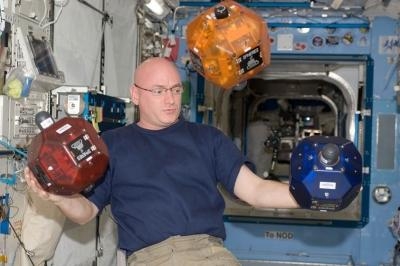Fri, Mar 21, 2014
Paves The Way For Future Deep Space Missions
In a breakthrough that will help make it possible for astronauts and robots to work together in deep space, researchers at the Lockheed Martin Advanced Technology Center (ATC), working with NASA astronauts aboard the International Space Station, have demonstrated coordinated control of robots in space by astronauts in space and operators on the ground. The breakthrough is the first-ever demonstration of such collaborative tele-operations. The maneuvers create new opportunities to extend the reach of human and robotic missions in Earth orbit and beyond.

Astronaut Karen Nyberg and ATC engineer Humberto Ormeno used an ATC-developed, 3-D user interface to command NASA's Synchronized Position Hold, Engage, Re-orient, Experimental Satellites (SPHERES) robots on the space station. Inside the space station, the robots (each about the size of a soccer ball) were commanded in "follow-the-leader" exercises and simulated approach-and-docking maneuvers, like those required for in-space assembly of large space structures and asteroid exploration. There is also flexibility within the system, meaning automated control of one or more robots can be combined with manual control of another.
Remote commanding of robots in space, or tele-operation, poses several unique challenges. Commands and telemetry can take one to three seconds to travel between space and the ground via satellite relays, forcing remote operators to predict the effects of their actions using old data. Delicate components designed for weightlessness can be damaged by accidental collisions or even exhaust gases produced by other satellites, so safe maneuvering is essential. The work on the space station is demonstrating how to deal with the time delays associated with signal transfer from the ground.
"The ATC has started to confront these challenges by performing multiple experiments with the SPHERES robots, through a no-cost Space Act Agreement with the International Space Station National Laboratory Office," said Dr. Nelson Pedreiro, ATC director of Science and Technology. "This technology exemplifies how breakthroughs can be achieved in a cost-effective and agile manner."
"Supervising a team of robots in microgravity requires intuitive and informative user interfaces so operators can maintain control over sensitive maneuvers without being overwhelmed by details," says Andrew Zimdars, who leads the ATC effort. "SPHERES enables us to work with the astronauts who will command future exploration missions and develop software technologies that meet their needs."
(SPHERES image provided by NASA)
More News
From 2023 (YouTube Version): Legacy of a Titan Robert (Bob) Anderson Hoover was a fighter pilot, test pilot, flight instructor, and air show superstar. More so, Bob Hoover was an i>[...]
Get The Latest in Aviation News NOW on Instagram Are you on Instagram yet? It's been around for a few years, quietly picking up traction mostly thanks to everybody's new obsession >[...]
Aero Linx: B-52H Stratofortress The B-52H Stratofortress is a long-range, heavy bomber that can perform a variety of missions. The bomber is capable of flying at high subsonic spee>[...]
Altimeter Setting The barometric pressure reading used to adjust a pressure altimeter for variations in existing atmospheric pressure or to the standard altimeter setting (29.92).>[...]
"Knowing that we play an active part in bettering people's lives is extremely rewarding. My team and I are very thankful for the opportunity to be here and to help in any way we ca>[...]
 Classic Aero-TV: Remembering Bob Hoover
Classic Aero-TV: Remembering Bob Hoover ANN FAQ: Follow Us On Instagram!
ANN FAQ: Follow Us On Instagram! ANN's Daily Aero-Linx (05.15.24)
ANN's Daily Aero-Linx (05.15.24) ANN's Daily Aero-Term (05.15.24):Altimeter Setting
ANN's Daily Aero-Term (05.15.24):Altimeter Setting Aero-News: Quote of the Day (05.16.24)
Aero-News: Quote of the Day (05.16.24)



